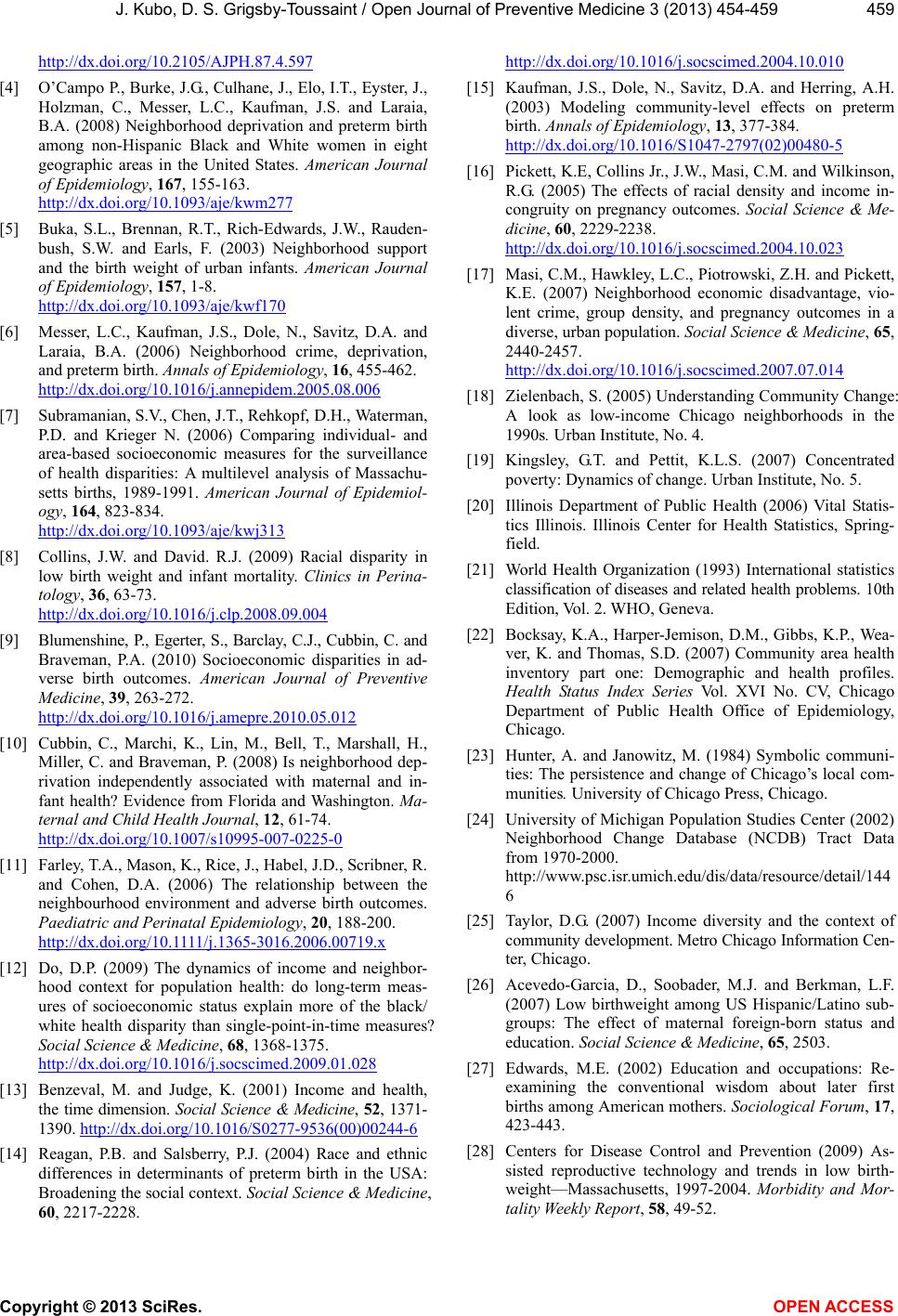
J. Kubo, D. S. Grigsby-Toussaint / Open Journal of Preventive Medicine 3 (2013) 454-459
Copyright © 2013 SciRes. OPEN A CCESS
459
http://dx.doi.org/10.2105/AJPH.87.4.597
[4] O’Campo P., Burke, J.G., Culhane, J., Elo, I.T., Eyster, J.,
Holzman, C., Messer, L.C., Kaufman, J.S. and Laraia,
B.A. (2008) Neighborhood deprivation and preterm birth
among non-Hispanic Black and White women in eight
geographic areas in the United States. American Journal
of Epidemiology, 167, 155-163.
http://dx.doi.org/10.1093/aje/kwm277
[5] Buka, S.L., Brennan, R.T., Rich-Edwards, J.W., Rauden-
bush, S.W. and Earls, F. (2003) Neighborhood support
and the birth weight of urban infants. American Journal
of Epidemiology, 157, 1-8.
http://dx.doi.org/10.1093/aje/kwf170
[6] Messer, L.C., Kaufman, J.S., Dole, N., Savitz, D.A. and
Laraia, B.A. (2006) Neighborhood crime, deprivation,
and preterm birth. Annals of Epidemiology, 16, 455-462.
http://dx.doi.org/10.1016/j.annepidem.2005.08.006
[7] Subramanian, S.V., Chen, J.T., Rehkopf, D.H., Waterman,
P.D. and Krieger N. (2006) Comparing individual- and
area-based socioeconomic measures for the surveillance
of health disparities: A multilevel analysis of Massachu-
setts births, 1989-1991. American Journal of Epidemiol-
ogy, 164, 823-834.
http://dx.doi.org/10.1093/aje/kwj313
[8] Collins, J.W. and David. R.J. (2009) Racial disparity in
low birth weight and infant mortality. Clinics in Perina-
tology, 36, 63-73.
http://dx.doi.org/10.1016/j.clp.2008.09.004
[9] Blumenshine, P., Egerter, S., Barclay, C.J., Cubbin, C. and
Braveman, P.A. (2010) Socioeconomic disparities in ad-
verse birth outcomes. American Journal of Preventive
Medicine, 39, 263-272.
http://dx.doi.org/10.1016/j.amepre.2010.05.012
[10] Cubbin, C., Marchi, K., Lin, M., Bell, T., Marshall, H.,
Miller, C. and Braveman, P. (2008) Is neighborhood dep-
rivation independently associated with maternal and in-
fant health? Evidence from Florida and Washington. Ma-
ternal and Child Health Journal, 12, 61-74.
http://dx.doi.org/10.1007/s10995-007-0225-0
[11] Farley, T.A., Mason, K., Rice, J., Habel, J.D., Scribner, R.
and Cohen, D.A. (2006) The relationship between the
neighbourhood environment and adverse birth outcomes.
Paediatric and Perinatal Epidemiology, 20, 188-200.
http://dx.doi.org/10.1111/j.1365-3016.2006.00719.x
[12] Do, D.P. (2009) The dynamics of income and neighbor-
hood context for population health: do long-term meas-
ures of socioeconomic status explain more of the black/
white health disparity than single-point-in-time measures?
Social Science & Medicine, 68, 1368-1375.
http://dx.doi.org/10.1016/j.socscimed.2009.01.028
[13] Benzeval, M. and Judge, K. (2001) Income and health,
the time dimension. Social Science & Medicine, 52, 1371-
1390. http://dx.doi.org/10.1016/S0277-9536(00)00244-6
[14] Reagan, P.B. and Salsberry, P.J. (2004) Race and ethnic
differences in determinants of preterm birth in the USA:
Broadening the social context. Social Science & Medicine,
60, 2217-2228.
http://dx.doi.org/10.1016/j.socscimed.2004.10.010
[15] Kaufman, J.S., Dole, N., Savitz, D.A. and Herring, A.H.
(2003) Modeling community-level effects on preterm
birth. Annals of Epidemiology, 13, 377-384.
http://dx.doi.org/10.1016/S1047-2797(02)00480-5
[16] Pickett, K.E, Collins Jr., J.W., Masi, C.M. and Wilkinson,
R.G. (2005) The effects of racial density and income in-
congruity on pregnancy outcomes. Social Science & Me-
dicine, 60, 2229-2238.
http://dx.doi.org/10.1016/j.socscimed.2004.10.023
[17] Masi, C.M., Hawkley, L.C., Piotrowski, Z.H. and Pickett,
K.E. (2007) Neighborhood economic disadvantage, vio-
lent crime, group density, and pregnancy outcomes in a
diverse, urban population. Social Science & Medicine, 65,
2440-2457.
http://dx.doi.org/10.1016/j.socscimed.2007.07.014
[18] Zielenbach, S. (2005) Understanding Community Change:
A look as low-income Chicago neighborhoods in the
1990s. Urban Institute, No. 4.
[19] Kingsley, G.T. and Pettit, K.L.S. (2007) Concentrated
poverty: Dynamics of change. Urban Institute, No. 5.
[20] Illinois Department of Public Health (2006) Vital Statis-
tics Illinois. Illinois Center for Health Statistics, Spring-
field.
[21] World Health Organization (1993) International statistics
classification of diseases and related health problems. 10th
Edition, Vol. 2. WHO, Geneva.
[22] Bocksay, K.A., Harper-Jemison, D.M., Gibbs, K.P., Wea-
ver, K. and Thomas, S.D. (2007) Community area health
inventory part one: Demographic and health profiles.
Health Status Index Series Vol. XVI No. CV, Chicago
Department of Public Health Office of Epidemiology,
Chicago.
[23] Hunter, A. and Janowitz, M. (1984) Symbolic communi-
ties: The persistence and change of Chicago’s local com-
munities. University of Chicago Press, Chicago.
[24] University of Michigan Population Studies Center (2002)
Neighborhood Change Database (NCDB) Tract Data
from 1970-2000.
http://www.psc.isr.umich.edu/dis/data/resource/detail/144
6
[25] Taylor, D.G. (2007) Income diversity and the context of
community development. Metro Chicago Information Cen-
ter, Chicago.
[26] Acevedo-Garcia, D., Soobader, M.J. and Berkman, L.F.
(2007) Low birthweight among US Hispanic/Latino sub-
groups: The effect of maternal foreign-born status and
education. Social Science & Medicine, 65, 2503.
[27] Edwards, M.E. (2002) Education and occupations: Re-
examining the conventional wisdom about later first
births among American mothers. Sociological Forum, 17,
423-443.
[28] Centers for Disease Control and Prevention (2009) As-
sisted reproductive technology and trends in low birth-
weight—Massachusetts, 1997-2004. Morbidity and Mor-
tality We ekly Report, 58, 49-52.